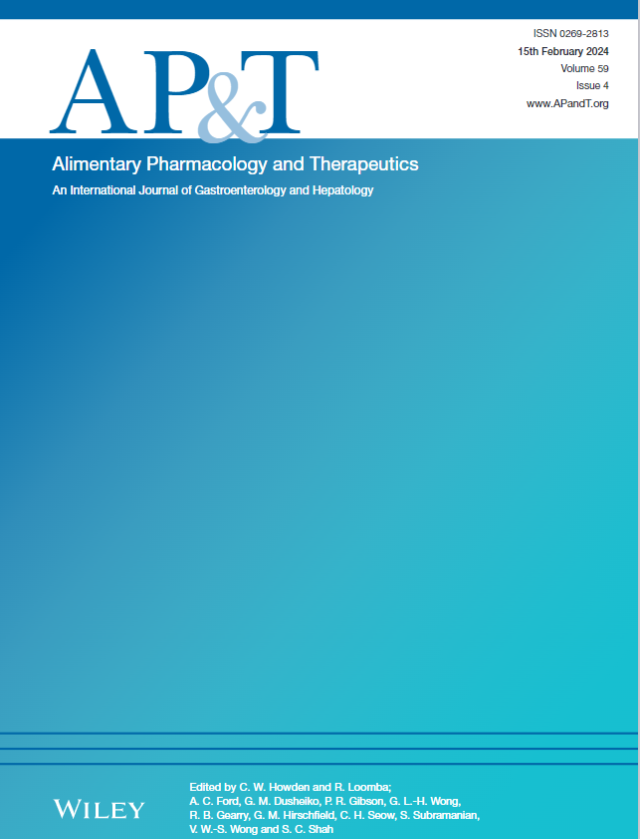Refining Prognosis in Cirrhosis Patients With Ascites: Impact of Acute vs. Non‐Acute Decompensation
IF 6.7
1区 医学
Q1 GASTROENTEROLOGY & HEPATOLOGY
引用次数: 0
Abstract
BackgroundA more granular understanding of hepatic decompensation in cirrhosis has led to the classification of acute decompensation (AD) and non‐acute decompensation (NAD). In this study, we assessed differences in the clinical course of AD versus NAD in patients with ascites as the first decompensation event.Methods505 cirrhosis patients with ascites as first decompensation were included in this single‐center longitudinal cohort study and followed until further decompensation, orthotopic liver transplantation (OLT), or death. AD was defined as grade 3 ascites or ascites with spontaneous bacterial peritonitis (SBP) or acute‐kidney injury (AKI), while NAD was defined as grade 2 ascites. Hospitalisation was recorded.ResultsAmong 505 patients, 296 (58.6%) met the criteria for AD, with 216 (73.0%) requiring hospitalisation. NAD occurred in 209 (41.4%), with 107 (51.2%) requiring hospitalisation.During a median 4.4‐year follow‐up, further decompensation occurred in 65.1%, acute‐on‐chronic liver failure (ACLF) in 27.7%, 10.9% underwent OLT, and 51.1% died. Patients with AD had a higher incidence of further decompensation (at 12 months: 19% and 33%) and a higher risk of transplant‐free mortality (subdistribution hazard ratio [SHR]: 1.43 [95% CI: 1.12–1.82],改善肝硬化腹水患者的预后:急性与非急性失代偿的影响
背景:对肝硬化肝失代偿的更细致的了解导致了急性失代偿(AD)和非急性失代偿(NAD)的分类。在这项研究中,我们评估了以腹水为首次失代偿事件的AD与NAD患者临床病程的差异。方法505例肝硬化腹水首发失代偿患者纳入本单中心纵向队列研究,随访至进一步失代偿、原位肝移植(OLT)或死亡。AD定义为3级腹水或腹水合并自发性细菌性腹膜炎(SBP)或急性肾损伤(AKI),而NAD定义为2级腹水。记录住院情况。结果505例患者中,296例(58.6%)符合AD标准,其中216例(73.0%)需要住院治疗。209例(41.4%)发生NAD, 107例(51.2%)需要住院治疗。在中位4.4年的随访中,65.1%的患者出现了进一步的失代偿,27.7%的患者出现了急性慢性肝衰竭(ACLF), 10.9%的患者接受了OLT治疗,51.1%的患者死亡。与NAD相比,AD患者有更高的进一步失代偿发生率(12个月时分别为19%和33%)和更高的无移植死亡风险(亚分布风险比[SHR]: 1.43 [95% CI: 1.12-1.82], p = 0.004)。当按住院情况分层时,AD仅在需要住院的病例中与死亡风险增加相关(住院AD与非住院NAD的SHR: 1.89, 95% CI: 1.35-2.65, p <;0.001)。炎症(C反应蛋白)预测AD移植后无移植死亡率(每对数变化SHR: 1.20 [95% CI: 1.02-1.41], p = 0.032),但对NAD无效。结论将患者分为AD和NAD,确定了进一步失代偿和无移植死亡风险不同的亚组。
本文章由计算机程序翻译,如有差异,请以英文原文为准。
求助全文
约1分钟内获得全文
求助全文
来源期刊
CiteScore
15.60
自引率
7.90%
发文量
527
审稿时长
3-6 weeks
期刊介绍:
Alimentary Pharmacology & Therapeutics is a global pharmacology journal focused on the impact of drugs on the human gastrointestinal and hepato-biliary systems. It covers a diverse range of topics, often with immediate clinical relevance to its readership.

 求助内容:
求助内容: 应助结果提醒方式:
应助结果提醒方式:


